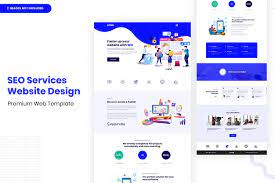The Impact of SEO Web Design on Your Online Presence
When it comes to establishing a strong online presence, the role of SEO web design cannot be overstated. In today’s digital landscape, having a visually appealing website is just one piece of the puzzle. To truly stand out and attract valuable organic traffic, your website must also be optimised for search engines.
SEO web design involves creating a website that not only looks great but is also structured and coded in a way that search engines can easily crawl and index its content. This ensures that your website ranks higher in search engine results pages (SERPs) for relevant keywords, increasing your visibility to potential customers.
One key aspect of SEO web design is ensuring that your website is mobile-friendly. With the majority of internet users now accessing websites on mobile devices, having a responsive design that adapts to different screen sizes is essential for both user experience and search engine rankings.
Additionally, incorporating relevant keywords into your website’s content, meta tags, and image alt text can help improve its visibility in search results. By conducting keyword research and strategically placing these keywords throughout your website, you can attract organic traffic from users actively searching for products or services like yours.
Another important element of SEO web design is creating high-quality, engaging content that not only informs visitors about your products or services but also keeps them on your site longer. Search engines reward websites that provide valuable content to users, so regularly updating your site with fresh, informative content can boost your search rankings.
In conclusion, SEO web design plays a crucial role in enhancing your online presence and driving organic traffic to your website. By implementing best practices such as mobile optimization, keyword integration, and quality content creation, you can improve your search engine rankings and ultimately reach more potential customers online.
8 Essential SEO Web Design Strategies to Enhance Visibility and User Experience
- Ensure your website is mobile-friendly for better SEO performance.
- Optimize your website’s loading speed to improve user experience and search engine rankings.
- Use relevant keywords in your content and meta tags to attract targeted traffic.
- Create high-quality, engaging content that encourages users to stay on your site longer.
- Optimize images by using descriptive filenames and alt text to improve SEO.
- Include internal links within your website to help search engines discover and index all pages.
- Make sure your website has a clear site structure with easy navigation for both users and search engines.
- Regularly monitor and analyse your website’s performance using tools like Google Analytics to make data-driven improvements.
Ensure your website is mobile-friendly for better SEO performance.
Ensuring that your website is mobile-friendly is a crucial tip for improving SEO performance. With the increasing number of users accessing websites on mobile devices, having a responsive design that provides a seamless experience across different screen sizes is essential. Search engines like Google prioritize mobile-friendly websites in their rankings, so by optimising your site for mobile, you can enhance user experience, increase engagement, and ultimately boost your visibility in search results. By embracing mobile responsiveness in your web design strategy, you can cater to a wider audience and improve your chances of attracting valuable organic traffic to your site.
Optimize your website’s loading speed to improve user experience and search engine rankings.
Optimising your website’s loading speed is a crucial aspect of SEO web design that can have a significant impact on both user experience and search engine rankings. A fast-loading website not only keeps visitors engaged and satisfied but also signals to search engines that your site is reliable and user-friendly. By minimising loading times through techniques such as image optimisation, browser caching, and code compression, you can enhance user experience, reduce bounce rates, and improve your site’s visibility in search results. Prioritising loading speed in your web design efforts can lead to higher conversions, increased traffic, and ultimately, a stronger online presence for your business.
Use relevant keywords in your content and meta tags to attract targeted traffic.
In SEO web design, incorporating relevant keywords strategically within your website’s content and meta tags is essential for attracting targeted traffic. By identifying and integrating keywords that align with your business offerings, you can increase the visibility of your website in search engine results pages. This targeted approach not only helps potential customers find your site more easily but also enhances the overall user experience by providing them with valuable and informative content that matches their search intent.
Create high-quality, engaging content that encourages users to stay on your site longer.
Creating high-quality, engaging content is a vital aspect of SEO web design that can significantly impact user experience and search engine rankings. By offering valuable and compelling content that captivates visitors, you not only encourage them to stay on your site longer but also increase the likelihood of them exploring more pages and engaging with your brand. Search engines value websites that provide relevant and informative content, rewarding them with higher visibility in search results. Therefore, by focusing on creating content that resonates with your target audience and keeps them engaged, you can enhance both user satisfaction and SEO performance on your website.
Optimize images by using descriptive filenames and alt text to improve SEO.
Optimizing images is a critical aspect of SEO web design. By using descriptive filenames and alt text for your images, you can significantly enhance your website’s visibility in search engine results. Search engines rely on these elements to understand the content of your images, so incorporating relevant keywords in both the filenames and alt text can help improve your website’s SEO performance. Additionally, descriptive filenames and alt text not only benefit search engines but also enhance user experience by providing context for visually impaired users and those with slow internet connections. By paying attention to these details, you can boost your website’s SEO and ensure that both search engines and visitors can easily understand the content of your images.
Include internal links within your website to help search engines discover and index all pages.
Including internal links within your website is a fundamental aspect of SEO web design that can significantly impact your online visibility. By strategically linking relevant pages within your site, you not only provide users with a seamless browsing experience but also help search engines discover and index all your pages effectively. Internal linking establishes a hierarchy of importance among your content, guiding search engine crawlers to understand the structure of your website and prioritise indexing key pages. This practice not only enhances the overall user experience but also boosts your website’s SEO performance by ensuring that all valuable content is accessible and visible to both users and search engines.
Make sure your website has a clear site structure with easy navigation for both users and search engines.
Ensuring that your website has a clear site structure with easy navigation is a fundamental aspect of SEO web design. A well-organised site layout not only enhances the user experience by helping visitors find the information they need quickly and efficiently but also makes it easier for search engines to crawl and index your content. By implementing intuitive navigation menus, clear page hierarchies, and descriptive internal linking, you can create a seamless browsing experience for both users and search engine bots, ultimately improving your website’s visibility and usability.
Regularly monitor and analyse your website’s performance using tools like Google Analytics to make data-driven improvements.
Regularly monitoring and analysing your website’s performance using tools like Google Analytics is a crucial aspect of effective SEO web design. By leveraging data-driven insights, you can gain a deeper understanding of how users interact with your site, identify areas for improvement, and make informed decisions to enhance its overall performance. Tracking key metrics such as traffic sources, user engagement, and conversion rates allows you to fine-tune your SEO strategies, optimise your website for better results, and ultimately drive meaningful growth in your online presence.



